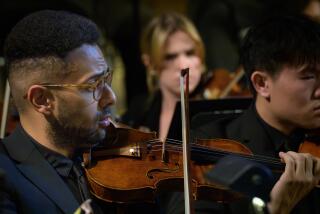Beaux Arts Trio at the Ace Gallery
The Beaux Arts Trio gave its first concert in the summer of 1955 at the Berkshire Music Festival in Massachusetts. The trio will close shop this summer at the same festival, now known as Tanglewood. But first the Beaux Arts has a lot of goodbyes to wave.
Thursday night, as part of their farewell tour, one tireless veteran pianist and two younger string players working hard to keep up offered a concert in the close quarters of the Ace Gallery in Beverly Hills. The music was mainly sweet, heartbreakingly beautiful Schubert. But Martin Schoeller’s female bodybuilders -- Ace’s exhibition of huge photographs of exceptionally formidable women -- stood guard, just in case anyone started to feel too cozy.
The Beaux Arts has had five violinists, three cellists and the irrepressible Menahem Pressler. A legend in chamber music circles, the 84-year-old pianist was born in Germany, was raised in Israel and has long lived in America. He teaches at Indiana University and his master classes are known for their exuberance.
The youngsters are the British violinist Daniel Hope, who joined the trio in 2002, and the Brazilian cellist Antonio Meneses, who has been a member for a decade. Hope is the problem. He has a contract with Deutsche Grammophon, which has just released his splendidly gallivanting performance of Mendelssohn’s Violin Concerto, and his ambitions are as a soloist. Pressler has chosen not to carry on with the trio without him.
In performance, Pressler looks like a salmon, in and out of water. He head-bobs. His mouth opens and closes, gasping for ever more blasts of melodic air. Throughout Schubert’s very special two piano trios Thursday, he turned to his companions, reacting with obvious pleasure to any caressing turn of phrase, but in fact did much of the musical caressing himself. Most of the time, he looked as though he was hearing this music for the first time.
And heaven was on his mind. Introducing Schubert’s Trio in B flat, he noted that this has been called the music angels listen to while on vacation. Speaking of the E-flat Trio, which Schubert performed shortly before his death at 31, Pressler described the ethereally lyric slow movement as a funeral march that was not sad but rather revealed “a way up.”
The evening was not sad either. Maybe those bodybuilders gave the players strength. In any case, this was among the most virile performances I’ve heard from the Beaux Arts. Fifty-three years ago, a full-time piano trio was a fresh notion. Around that time, Jascha Heifetz, Arthur Rubinstein and Gregor Piatigorsky liked to play together and were dubbed “The Million Dollar Trio.” Audiences had grown to expect stars in this chamber music configuration.
The Beaux Arts brought an ensemble tightness and luxurious sound not before commonplace to the trio repertory, but it also developed something of a bland smoothness as its name became synonymous with predictably exceptional quality. Still, what group that lasts more than half a century won’t have its stale years?
The startling aspect of Thursday’s concert was its renewed sense of discovery. The B-flat Trio, played before intermission, was given dramatic sweep but with time taken to ponder the smallest exquisite detail. The E-flat, 45 minutes long, began and ended with gusto. Pressler’s playing sparkled. The strings embraced melodies with bear hugs.
Schubert is often accused of heavenly length, so between these two trios, the Beaux Arts added the opposite. Hungarian composer György Kurtág recently wrote a 2 1/2 -minute trio, untitled, for the ensemble. It contains few notes and rarely rises above a whisper, the rustling of butterfly wings. The sound of buses on Wilshire was its competition but couldn’t crush such sonic intensity. The score was played twice -- but not as a repeat, Pressler noted, rather as a new experience.
However curious the environment, the Ace Gallery was a place where the Beaux Arts could play its last concert in L.A. among friends. Ace invites art world insiders to a chamber music series but also makes free tickets available to the public, who need only call and ask for them. What a great way to run a gallery.
More to Read
The biggest entertainment stories
Get our big stories about Hollywood, film, television, music, arts, culture and more right in your inbox as soon as they publish.
You may occasionally receive promotional content from the Los Angeles Times.











